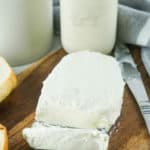Homemade Cream Cheese
Making homemade cream cheese is so easy! You can use this plain cream cheese for bagels, baking, and savory recipes.
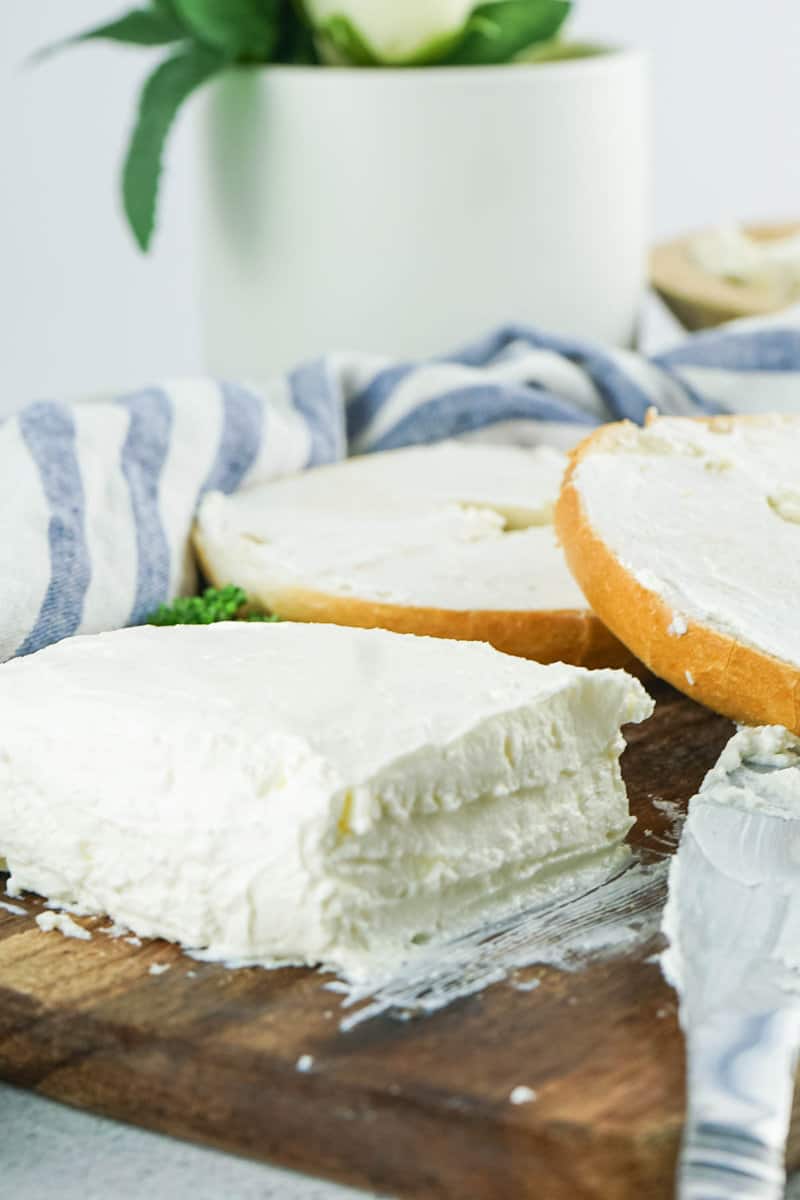
Homemade Cream Cheese From Scratch
I love cream cheese; it has been the salvation of many of my favorite meals. Making homemade cream cheese came about because one year I decided to cook a dish every week that included one specific ingredient, and I chose cream cheese.
When I announced my intentions on Twitter, I got a reply back from Michael Ruhlman, a cook and author, who believes the world is a better place when we cook our own food and share it with the people we love. So I was inspired to look up how to make cream cheese at home.
Homemade Cheeses
Many fresh cheeses – that is, cheeses that don’t have to be aged – you can make at home. Often it is simply a matter of adding lemon juice to milk and letting it sit on the counter for 12 to 24 hours – voila, homemade ricotta!
Leave the curds to grow a little more, and you have farmer’s cheese. This type of cheese is wonderful for breakfast. Spread it some on some toast, and you have a really tasty start to your day.
Why Homemade Cream Cheese Is Worth It
You may ask, why would you make your own cream cheese? Basically, you don’t do it because it is more economical.
The real reason to make your own cream cheese is to enjoy crafting your own cheese. It’s so satisfying and isn’t hard. The final product you get is a wonderful homemade organic cream cheese that tastes rich and tangy.
When you make DIY cream cheese from scratch, you have total control over the ingredients. Plus you don’t have to be concerned with a cream cheese shortage.
DIY Cream Cheese is Easy!
You will be really amazed at how easy it is to make homemade cream cheese. This would be a fantastic project for kids, there is very little measuring.
Ingredients to Make Your Own Cream Cheese
- Half and half
- Mesophilic culture
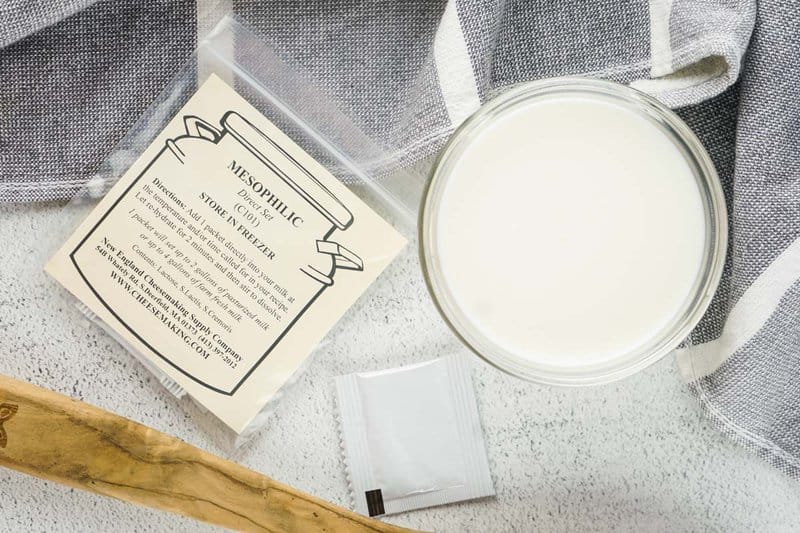
Ingredient Notes
Mesophilic culture is a mix of different bacteria and enzymes. I don’t know of any substitute for this for making homemade cream cheese.
You can use up to 2 gallons of half and half for this homemade cream cheese recipe. You do not need to increase the amount of the culture.
I have not made this recipe with heavy cream, whole milk, skim milk, or any other type of milk. I can’t speak to if that would work for those types of milk products.
Supplies & Equipment Needed for DIY Cream Cheese
For your adventure in making homemade cream cheese, you do need some supplies:
- Butter muslin (also called butter cloth), has a finer weave than cheesecloth. It is used to drain the whey from the cheese. Or you could use a flour sack towel.
- You will need a flat, shallow container. I used a 9 X 13-inch baking pan.
How to Make Homemade Cream Cheese
- Allow your half and half to reach room temperature. Your cheese will set more quickly if it isn’t refrigerator chilled when you add the starter culture.
- Add half and half to a large container. I recommend using a 9×13-inch baking dish.
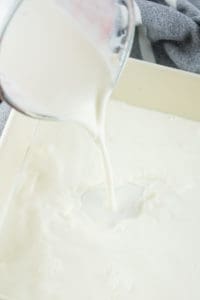
- Add the culture, sprinkling it over the top. Let it sit for about two minutes.
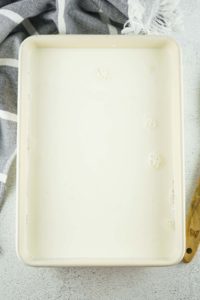
- Give the mixture a good stir with a spoon.
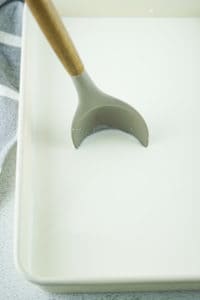
- Place some plastic wrap over the top of the dish and let it set on the counter for anywhere from 8 to 12 hours. When the cream cheese is set, it will have the texture of yogurt. It will appear to you that the whole process isn’t going to work, but here is where you wait and be patient. It can take about 10 to 12 hours for the cream cheese to set in a cooler house, so be patient.
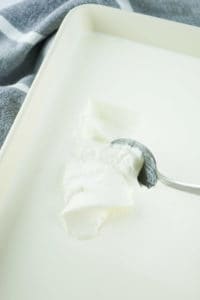
- Place the soft cream cheese into a double-layered butter muslin.
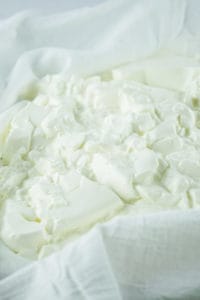
- Gather up the cloth and twist the top. Hant it to let the whey liquid drain out of it for up to 12 hours.
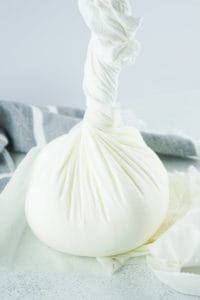
- Once the whey has drained, it will have the density and texture of store-bought cream cheese.
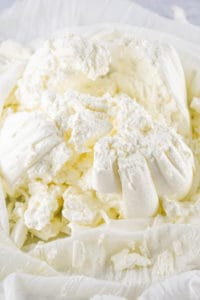
- Transfer the cream cheese to an airtight container or press it into a block.
- Serve it in a bowl or as a block on a tray with crackers or bagels.
This recipe makes 8 to 10 ounces of cream cheese.
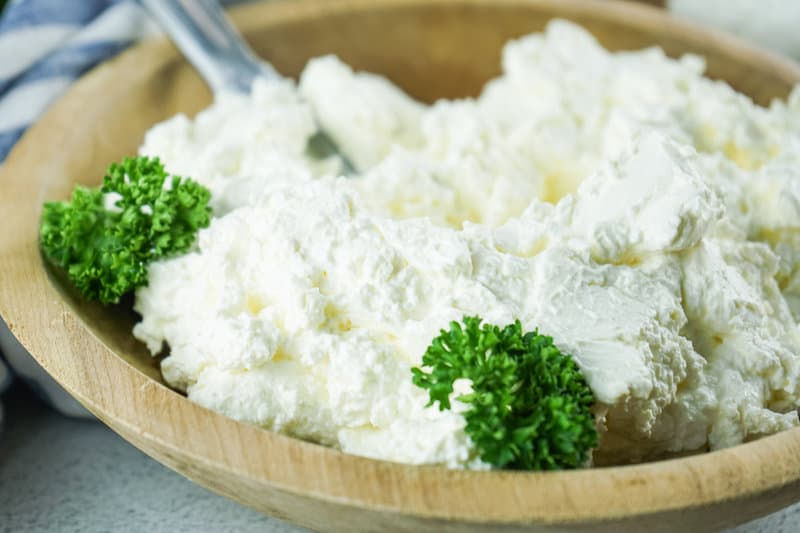
Homemade Cream Cheese Variations
Once you have your delightful homemade cream cheese, you can package it into smaller containers.
- Stir in some chives or herbs for various flavors.
- Stir in jam for a nice treat for breakfast.
- Add honey, cinnamon, and walnuts for a sweet creamy taste.
- Serve it covered in Jan sauce for an appetizer.
- Combine with smoked salmon or lox for a classic taste.
- You can add a little salt if you like. Cheese salt or pickling salt works best as both have finer grains than regular table salt.
Best Ways to Enjoy Homemade Cream Cheese
Cream cheese is perfect for that tasty schmear on your bagel, the best part of your carrot cake with cream cheese frosting, cheesecake, or the creamy cheese ingredient in dip recipes.
Don’t forget your Everything Bagel Seasoning!
How long will cream cheese from scratch last?
Store the cream cheese in an air-tight container in the fridge where it will be good for a few days.
Can you freeze cream cheese?
Yes, you can. However, the texture will change dramatically, so you probably wouldn’t want to spread it on your morning bagel. Cream cheese from the freezer is best reserved for baking or any other use where its grainy texture won’t be noticeable, such as in casseroles.
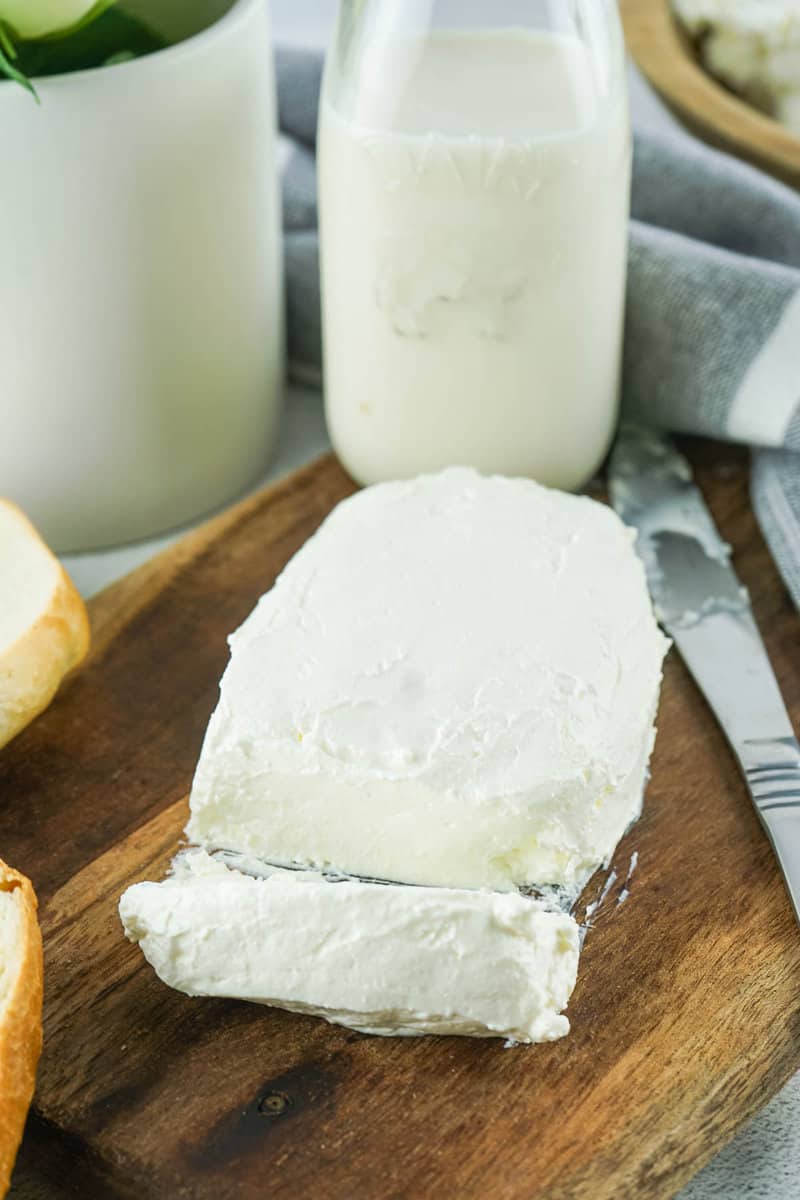
Homemade Cream Cheese FAQ
Is it cheaper to make your own cream cheese?
You may ask, why would you make your own cream cheese? Basically, you don’t do it because it’s more economical. However, if you are into organic eating, organic cream cheese is pricy, so making your own cream cheese from scratch isn’t quite as expensive.
What is the main ingredient in cream cheese?
Cream cheese ingredients are very simple, and you only need two! The main ingredient in this cream cheese recipe is half-and-half, to which you add a culture.
Can you use regular milk or skim milk to make cream cheese?
Yes, you can, but keep in mind that skim milk is better suited to making hard cheeses such as parmesan and romano. When making cream cheese, skim milk will not give you that rich and creamy cheese taste you expect from cream cheese.
What culture do you need to make homemade cream cheese?
The culture used in this cream cheese recipe is mesophilic culture.
What is mesophilic culture?
Mesophilic culture is a cheese culture best suited to work in moderate temperatures, i.e., half-and-half that is neither too hot nor too cold. It provides the proper bacterial organisms to turn half-and-half into wonderful homemade cream cheese.
Can I make cheese with yogurt or buttermilk?
Yes, you can, but it’s not recommended for a novice cheesemaker. There is some overlap between the bacteria in the mesophilic culture and the bacteria in yogurt and buttermilk. You can produce a variety of cream cheese recipes, but they won’t be the same as this one.
Would it spoil the cheese if the room is warm in the summertime?
Your homemade cream cheese will be ok with temperatures of 65 to 75 degrees Fahrenheit.
Can I make cheese with yogurt or buttermilk?
Yes. Yes, you can. Here is why I don’t entirely recommend it for the novice. Actually, you can try to make it with the ambient bacteria in the air, it could turn out, but most likely it will fail. This is how it was originally discovered thousands of years ago. Over time our ancestors realized you could reproduce it by using whey as a starter and they would get more dependable results.
I personally think if you are trying this for the first time you should spring a couple of bucks for culture and get dependable results. I looked up the bacteria that are in both mesophilic culture and buttermilk. They are as follows.
Mesophillic culture may contain lactose, lactococcus lactis subsp. lactis, lactococcus lactis subsp. cremoris
Buttermilk may contain lactose, (LL) lactococcus lactis subsp. lactis, (LLC) lactococcus lactis subsp. cremoris, (LLD) lactococcus lactis subsp. biovar diacetylactis, (LMC) leuconostoc mesenteroides subsp. cremoris.
Yes, there is some overlap. As you can see they are not the same, so sure you will produce a type of cream cheese but isn’t the recipe that I am sharing.
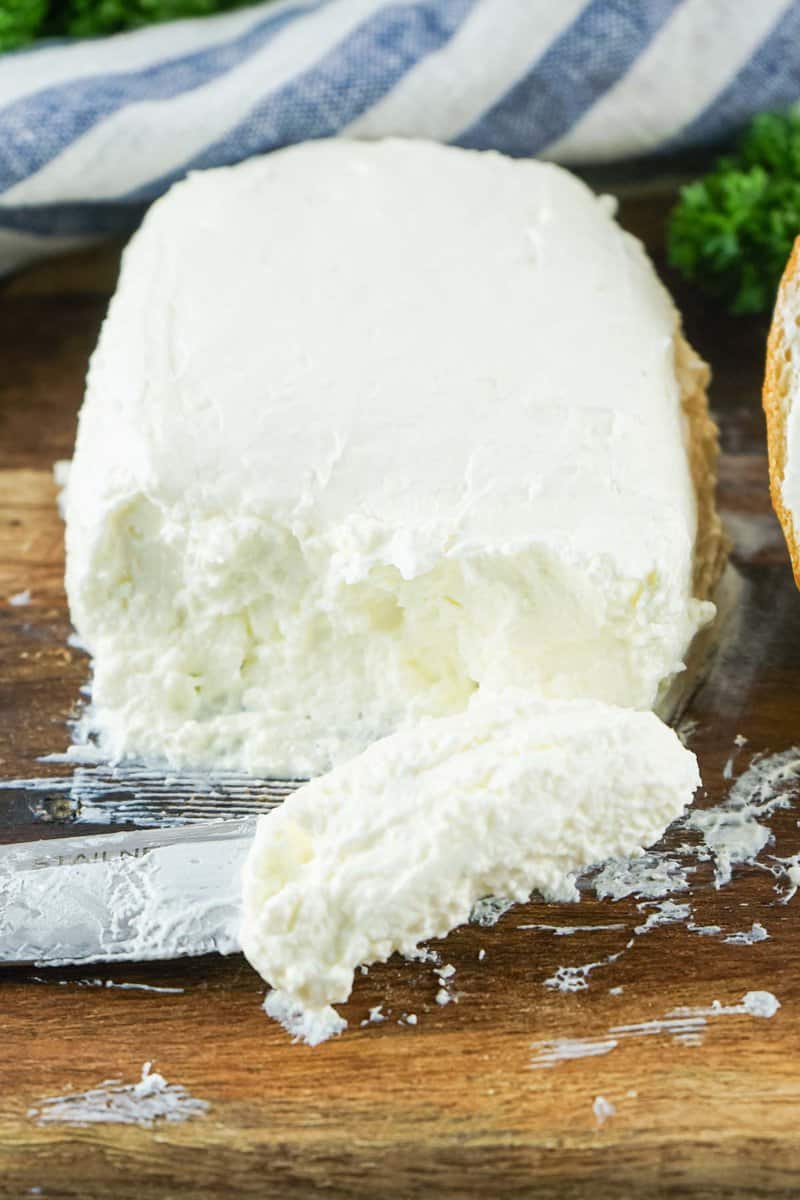
Best Ways to Enjoy Home Made Cream Cheese
Use homemade cream cheese in these recipes:
- Blueberry Cream Cheese Pie
- Clam Dip with Cream Cheese
- Cream Cheese Chicken
- Cream Cheese Wontons
- Grape Salad with Cream Cheese
- Honey Walnut Cream Cheese Spread
- Lemon Cream Cheese Pie
- Sausage Cream Cheese Dip
- Strawberry Cream Cheese
- Zucchini Cake with Cream Cheese Frosting
Popular DIY Recipes
Check out more of my easy dessert recipes the best DIY recipes here on CopyKat!
Homemade Cream Cheese
Ingredients
- 2 quarts half and half
- 1 package mesophilic culture
Instructions
-
Allow your half and half to reach room temperature, your cheese will set more quickly if it isn’t refrigerator chilled when you add the starter culture.
-
Pour half and half into a large flat container, like a 9 x 13-inch baking pan.
-
Sprinkle mesophilic culture into half and half. Wait about two minutes for the culture to bloom, then stir in the culture.
-
Seal the baking dish with plastic wrap. Leave the milk mixture outside on the countertop for about 8 to 12 hours, or until it begins to set up.
-
The cream cheese has set up properly when it has the consistency of Greek yogurt.
-
You will want to fold over the butter muslin so the fabric is double layered. Place the soft cheese into the butter muslin and hang it so the whey drains out. It may take up to 12 hours for the whey to drain out.
-
Once the whey is drained out, transfer the cream cheese to an airtight container. You can serve it as-is or form it into a block.
-
Store the cream cheese in the refrigerator.
Video
Notes
.
Nutrition
The post Homemade Cream Cheese appeared first on CopyKat Recipes.

